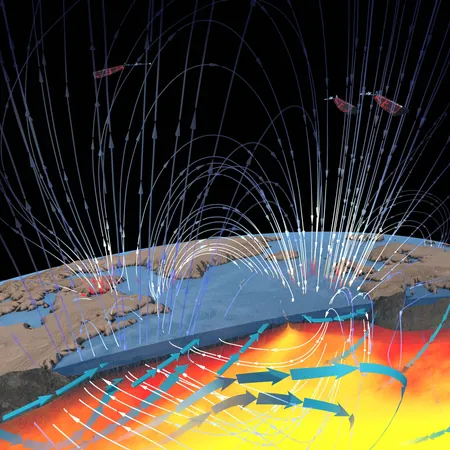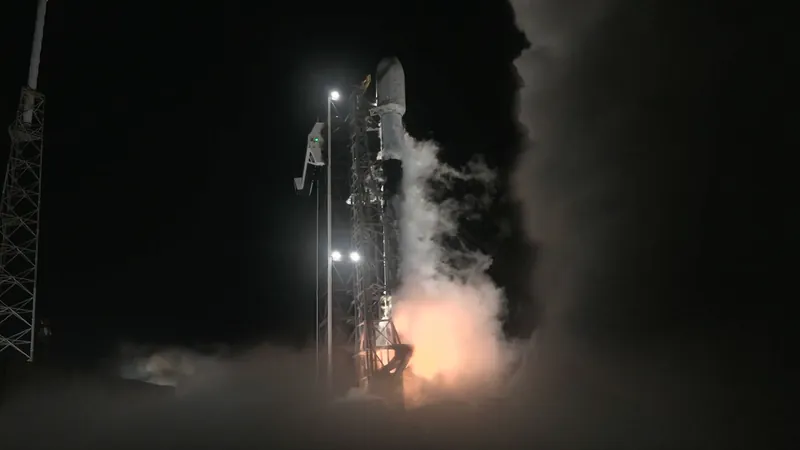
Revolutionary Discovery: Ocean Tides May Hold Secrets to Magma Distribution and Global Climate Trends!
2025-01-22
Author: Sarah
Introduction
A groundbreaking study utilizing data from the European Space Agency's (ESA) Swarm mission has unveiled that the subtle magnetic signatures produced by Earth's ocean tides could be pivotal in mapping magma distribution beneath the seabed. This remarkable finding also promises to shed light on significant long-term trends in global ocean temperatures and salinity levels.
The Swarm Mission
Swarm consists of a powerful trio of satellites dedicated to studying Earth's geomagnetic field—an invisible force extending from the planet's core into the vastness of space. This magnetic field is primarily generated by a dynamic ocean of molten iron within Earth's outer core, supplemented by magnetized rocks in the crust.
The Role of Oceans in Magnetism
Often overlooked, our oceans are not just vast bodies of water; they play an essential role in magnetism due to their saline composition, which allows seawater to conduct electricity moderately well. Whenever ocean tides move across Earth's magnetic field, they induce weak electric currents, leading to faint magnetic signals detectable from space.
Precise Measurements and Insights
Operating at altitudes ranging from 462 km to 511 km, Swarm has achieved unprecedented precision in measuring Earth's magnetic field. By discerning these delicate tidal signatures from more potent magnetic sources originating from our planet's interior, researchers can now gather extensive insights into the properties of ocean waters, as highlighted by ESA's Swarm Mission Manager, Anja Strømme.
Implications for Volcanology
Intriguingly, Swarm's data could significantly advance our understanding of volcanic activities, drawing connections to events like the Hunga-Tonga eruption of 2022. This study made waves by featuring on the cover of Philosophical Transactions of the Royal Society A, underscoring its importance and the collaborative efforts of teams from the University of Cologne and the Technical University of Denmark.
A Mission Beyond Expectations
Launched in 2013 with an initial four-year lifespan, Swarm is now thriving in its twelfth year. Anja Strømme remarked, "The longevity of our missions allows us to tackle unexpected scientific inquiries that arise." However, as the satellites face natural degradation due to atmospheric drag drawing them closer to Earth, the technology on board has become increasingly adept at capturing weaker signals—something that would have been challenging at the higher altitudes observed at mission commencement.
Evolution of Technology
This evolution has coincided with reduced solar activity, especially noted during 2017's solar minimum, leading to more pronounced oceanic magnetic signals. Lead author Alexander Grayver from the University of Cologne explained, "The data retrieved during this quiet period of the sun were particularly pristine, allowing for the detection of subtle signals that were previously undetectable amidst solar interference."
Future Prospects
As scientists gear up for the next solar minimum projected after 2030, the hope remains that Swarm will still be operational, continuing its vital work of uncovering the mysteries of our oceans' depths and significantly contributing to climate science and volcanology in ways previously unimaginable.
Conclusion
Could this discovery change the way we monitor our planet's geological and climatic systems forever? Stay tuned as we uncover more groundbreaking findings from the Swarm mission in the future!


 Brasil (PT)
Brasil (PT)
 Canada (EN)
Canada (EN)
 Chile (ES)
Chile (ES)
 Česko (CS)
Česko (CS)
 대한민국 (KO)
대한민국 (KO)
 España (ES)
España (ES)
 France (FR)
France (FR)
 Hong Kong (EN)
Hong Kong (EN)
 Italia (IT)
Italia (IT)
 日本 (JA)
日本 (JA)
 Magyarország (HU)
Magyarország (HU)
 Norge (NO)
Norge (NO)
 Polska (PL)
Polska (PL)
 Schweiz (DE)
Schweiz (DE)
 Singapore (EN)
Singapore (EN)
 Sverige (SV)
Sverige (SV)
 Suomi (FI)
Suomi (FI)
 Türkiye (TR)
Türkiye (TR)
 الإمارات العربية المتحدة (AR)
الإمارات العربية المتحدة (AR)